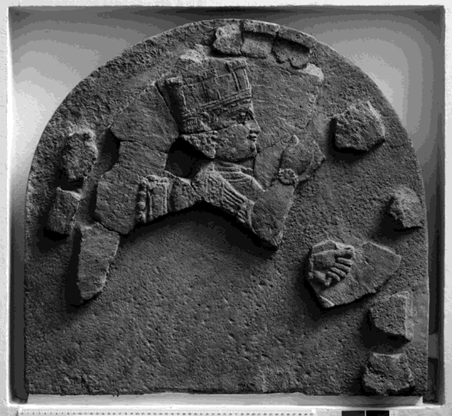

 | Object type: Stele |
| Museum: VA 8847, Vorderasiatische Museum, Staatliche Museen zu Berlin | |
| Findspot: Excavated/Findspot: Assur (Qal’at Sherqat, north of Iraq) | |
| Culture, period: Neo-Assyrian | |
| Production date: 672-631 BCE (?) | |
| Material: Limestone | |
 | Dimension: |
 | Nonverbal Communication: |
Description:
The stele was installed in the so-called Stelenreihe at Assur and found in the post-imperial building where it was used as a floor pavement. The queen is identified by the inscription as “[I]mage of Libbāli-šar[rat], que[en] of Ashurbani[pal], king of the world, ki[ng] of As[syria]”.
The queen holds a flower and sits on a throne. She is depicted with an upright posture and a stance like the one which is held by the Assyrian king. The right hand, although fragmentary, seems to represent a particular gesture which involves the lifted right hand positioned at the level of the face. This gesture has been interpreted as the so-called karābu, which the standard lexicons gloss as “to greet, pray, bless, praise”. In a context of meeting with an authoritative figure, this gesture should be read as a formal and reciprocal greeting and would mark the beginning of the audience. According to Assyrian visual evidence, it seems that the gesture – which can be performed by an authoritative personality or a subordinate – connoted a reciprocal relationship governed by mutual obligations and benefits.
The fragmentary status of the stele, together with the unclear meaning of the Stelenreihen in Assur, do not allow to draw any conclusions about to whom the queen addresses her greeting/blessing gesture. The top-right side of the stele may have shown divine symbols, as this was a common practice in Assyrian art, so the queen may be perennially greeting or blessing the deities. Alternatively, if we take for granted the interpretation that the place where the stelae were found was a depository, i.e. a favissa, for monuments removed from a shrine, then the stelae may have performed the function of suppliants and statues set up in temples. By contrast, if the stelae were displayed along roads, then the gesture would have been addressed towards any passer-by, be it human or divine.
Bibliographic references:
Andrae W. 1913: Die Stelenreihen in Assur (Wissenschaftliche Veröffentlichung der Deutschen Orient-Gesellschaft 24), Leipzig, 6–8, fig. 3 and pl. 10/1 (first edition, picture)
Macgregor S.L. 2012: Beyond Hearth and Home: Women in the Public Sphere in Neo-Assyrian Society (State Archives of Assyria Studies 21), Helsinki, 88–89 (study)
Kertai D. 2013: “The Queens of the Neo-Assyrian Empire”, Altorientalische Forschungen 40/1, 119 (study)
Svärd S. 2015: Women and Power in the Neo-Assyrian Palaces (State Archives of Assyria Studies 23), Helsinki, 75–77 (study)
http://oracc.museum.upenn.edu/rinap/rinap5/pager (inscription)
May N.N. 2018: “Neo-Assyrian Women, Their Visibility, and Their Representation in Written and Pictorial Sources”, in S. Svärd / A. Garcia-Ventura (eds.), Studying Gender in the Ancient Near East, University Park, 253–254 (study)
Portuese L. 2022: “A Gender-Centered Perspective on Manners and Etiquette for Understanding the Historical Role of the Assyrian Queen”, KASKAL Rivista di storia, ambienti e culture del Vicino Oriente Antico 19, 50–52 (study)
© Image credits: BPK, Vorderasiatische Museum, Staatliche Museen zu Berlin. Drawing by Andrae 1913, fig. 3.
